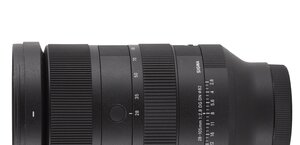Sigma C 24 mm f/3.5 DG DN
5. Chromatic and spherical aberration
Chromatic aberration
With such an aperture fastness and angle of view we didn't expect any problems connected to longitudinal chromatic aberration, especially that the optical construction of the tested lens features low dispersion glass. Photos, presented below, show clearly that indeed in this category the lens fares very well. You can notice very faint traces of colouring only at the maximum relative aperture but they disappear already on slight stopping down. |
A graph, shown below, presents the lateral chromatic aberration performance, depending on the detector and aperture values.

You won't see any serious issues in this category; only near the maximum relative aperture, and on the edge of the APS-C the values approach a borderline between low and medium levels. Overall the results are better than those of the rival Samyang and Sony devices. Only the Tamron managed to outperform the Sigma here as its aberration never exceeded 0.06%.
Please Support UsIf you enjoy our reviews and articles, and you want us to continue our work please, support our website by donating through PayPal. The funds are going to be used for paying our editorial team, renting servers, and equipping our testing studio; only that way we will be able to continue providing you interesting content for free. |
- - - - - - - - - - - - - - - - - - - - - - - - - - - - - - - - - - - - - - - - - - - - - - - -
| A7R III, RAW, FF, f/3.5 | A7R III, RAW, FF, f/16.0 |

|

|
Spherical aberration
First photos of this chapter don't feature any noticeable 'focus shift' effect. When it comes to circles of light reached before and behind the focus, they don't look identical but the differences between them are hardly pronounced, concerning mainly concentric circles inside. Overall you can say that the Sigma C 3.5/24 doesn't have any important problems when it comes to correction of spherical aberration.
| A7R III, f/3.5, before | A7R III, f/3.5, after |

|

|






